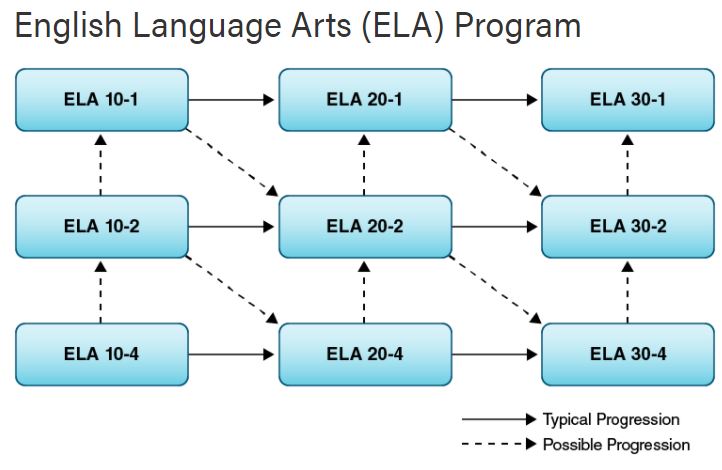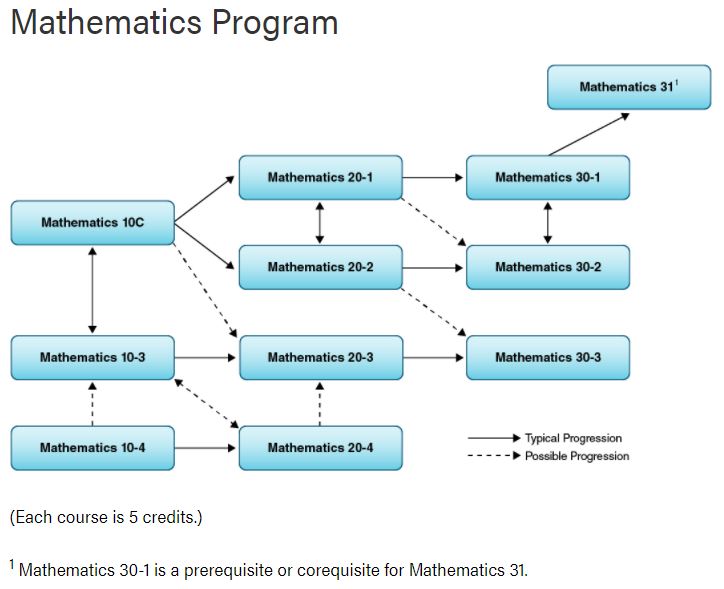Grade 11 Core Programs
ENGLISH LANGUAGE ARTS
ELA 20-1 (min 60%+ in 10-1) > ELA 30-1 |
Students continue to develop their interpretive skills through the study of a variety of text forms, including visuals. The focus is on developing their own unique writing style and developing their abilities to analyze the writing styles of authors and text creators. Students are introduced to rhetoric and other stylistic devices, with the expectation that they integrate these elements into their own writing assignments and projects in a variety of forms. |
ELA 20-2 (min 50%+ in 10-2 or 40%+ in 10-1) > ELA 30-2 |
Thematic units are at the center of the program, providing opportunities for students to develop their ability to form impressions and connect themselves and others to the ideas presented to them in texts studied. Emphasis is placed on persuasive writing forms, as well as writing that connects themselves and their experiences to those of the characters and situations they read about. |
SOCIAL STUDIES
SOCIAL 20-1 (min 60% in Social 10-1) > 30-1 |
Content Application, Evaluation, Analysis, and Synthesis of content is required and assessed. |
Skills Critical Thinking and Analytical Writing Interpretation of Written and Visual Sources |
Writing Source Interpretation and Identification of Relationships Position Paper **Foundational of academic writing in Post-Secondary** |
SOCIAL 20-2 (min 50%+ in 10-2 OR 40%+ in 10-1) > 30-2 |
Content Comprehension and Application is required and assessed. |
Skills Critical Thinking and Personal Writing Understanding Written and Visual Sources |
Writing Content and Vocabulary Based Writing Source Interpretation with Personal Response Identify and Evaluate Perspective |
MATHEMATICS
Ready to Work/Many Trades
MATH 20-3 > Math 30-3 |
Develop spatial sense through direct and indirect measurement. Develop spatial sense. Develop number sense and critical thinking skills. Develop algebraic reasoning. Develop statistical reasoning. |
MATH 20-2 > Math 30-3 |
Develop spatial sense and proportional reasoning. Develop spatial sense. Develop number sense and logical reasoning. Develop statistical reasoning. Develop algebraic and graphical reasoning through the study of relations. |
College, University, Medicine, Engineering & Some Science Based Programs
MATH 20-1 > Math 30-1 > Math 31 |
Develop algebraic reasoning and number sense. Develop trigonometric reasoning. Develop algebraic and graphical reasoning through the study of relations. Develop algebraic and graphical reasoning through the study of relations. |
SCIENCES
Ready to Work/Many Trades
SCIENCE 24 |
Science 24 students will investigate units such as: Matter & Chemical Change Energy Transformation Disease Defense Safety & Transportation |
Some College & Some University Programs
SCIENCE 20 > Science 30 |
Students investigate concepts in: Biology Chemistry Physics Earth Science |
Science 30 is the preferred course for many programs in technical institutions, especially if a student is only able to complete one science.
Science 30 is recognized by universities in Alberta as one of the 5 courses that a student can present for entry into several faculties that relate to careers in the humanities or fine arts.
College, University, Medicine, Engineering & Some Science Based Programs
BIOLOGY 20 > Biology 30 |
Biology 20 students can expect to study to following concepts: Energy flow in ecological systems (Ecology) How ecosystems are affected by human enterprise (Ecology, Biomes) Thermodynamics, Photosynthesis, Cellular Respiration Human digestion, respiration, excretion, circulation and muscular systems (Anatomy and Physiology) Variation, diversity and evolution Societal issues in science and technology related to these biology concepts. |
PHYSICS 20 > Physics 30 |
Energy is the theme common to all units. Kinematics (how things move) Dynamics (the forces that cause movement) Circular Motion and Gravitation Work and Energy Oscillatory Motion and Mechanical Waves
|
Chemistry 20 > Chemistry 30 |
Chemistry 20 students will focus on investigating: Gravimetric Stoichiometry – problem solving Gas Behaviour – gas laws, characteristics of gases, gas stoichiometry Solutions – characteristics, concentration, conductivity, solution stoichiometry Acids and Bases – pH scale, stoichiometry, titrations Bonding – atomic and compound structure, shape of compounds, polarity |
For more detailed program information, please read through the course descriptions:
Grade 11 Course Planner and Frequently Asked Questions




